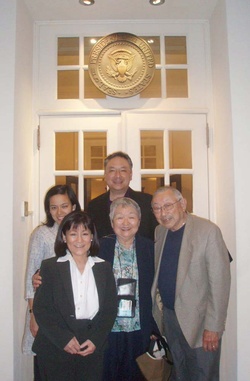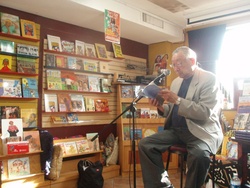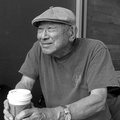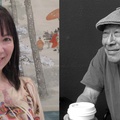It was a windfall event, unexpected and surreal, especially the jaw-dropping reaction of the people.
“You mean The White House?”
“Yes.”
“You’re kidding me?”
“No.”

The group outside the West Wing Entrance: Anne Francis (front), Nina Fallenbaum (back), my son Soji, my wife Sadako and me
And we showed the invitation from The President and Mrs. Obama to An Evening of Poetry at The White House on Wednesday, May 11, 2011 at six thirty o’clock.
On Monday evening we were met at the airport by Dr. Raymond Murakami, a prominent dentist to Washington, D.C. power brokers, politicians, and celebrities such as the late actress Elizabeth Taylor. Retired after a 50-year career, Ray has been an active leader of the National Japanese American Memorial.
I knew Ray as a young teenager in Tule Lake Concentration Camp. In fact, he was the pitcher on our championship Block 40 softball team. Ray drove us to Lorien Hotel & Spa in Alexandria, Virginia from where we commuted to Washington, D. C. via Metro which was like riding BART in the Bay Area.
On Tuesday, we went to the Price of Freedom—Americans at War exhibit at the Smithsonian National Museum of History. Then Noriko Sanefuji took us to the Japanese American National Memorial to Patriotism during World War II, following which we took in the Lincoln Memorial and the Washington Monument.
One of the highlights of the day for me was the book reading and signing that I did in the evening at Sankofa Books and Café, an African American bookstore near Howard University. Before a sympathetic audience of African Americans, Asians, and Caucasians, I had a great time reading and talking about our Japanese American experience. After the reading event, I had the pleasure and honor of meeting Congressman Mike Honda of San Jose.
Later that evening, Mr. Honda kindly drove us to the White House where we were given a tour of the West Wing by Bryan Jung, an extremely knowledgeable and affable guide. What a privilege it was to actually be there, in the historic building, the Capitol of our country, the seat of power, and see what we had only glimpsed on television—the Rose Garden & South Lawn, the West Colonnade to the Executive Residence, the Vice President’s Hallway, the Navy Mess, the Cabinet Room, the Roosevelt Room, the James S. Brady Press Briefing Room, and the Oval Office.
Late afternoon on Wednesday, after our visit to the American Indian Museum, Anne Francis graciously waited with us at the patio café of the Washington Hotel opposite the Southeast Gate and made sure we entered The White House before leaving us.
After going through two security points, we were welcomed and directed by gracious uniformed men and women to the rotunda where we were served champagne, wine or soft drinks. Everyone seemed happy to be there. I wondered if they were all poets. I asked a man standing nearby who looked overwhelmed as I was, if he was a poet. He was not. He worked for a government agency that had something to do with culture. I realized then that this was not an event honoring poets but a celebration of poetry and that we were there as part of the celebration. I then enjoyed my champagne.
Soon we were directed to the East Room for the program. President Obama’s opening remarks included some welcome unscripted humor. Among the poets were two former United States Poet Laureates Billy Collins and Rita Dove; other distinguished poets were Kenneth Goldsmith, Alison Knowles, Aimee Mann and Jill Scott. Two younger poets were Moira Bass, an eighth grader; and Youssef Biaz, a high school senior. The program also included the rapper Common who was the subject of controversy before the event brought on by such non-poets as Sean Hannity, Rush Limbaugh, Glenn Beck and Republican super critics Karl Rove and Sarah Palin. The last performer was Steve Martin, the most diversified artist, making his first appearance at the White House. He and his blue grass band performed a song adapted from a poem by W. H. Auden.
We just happened to be at a table where the poets, musicians and the President and Mrs. Obama entered from the Green Room and when they exited the same way—President Obama and Mrs. Obama shaking the hands of the people along the way—my wife and I got to shake their hands.
The question is: why were we there? We were told that we were the only Asians at the event. Indeed, I didn’t see any other Asian looking person. Were we representing the Asian community? I don’t know. This I know—that Washington is a town based on contacts and there are many who work here with good will, especially among the Asians. Well, unknown to me, my good contact knew the person working on this project and recommended me. For whatever reason, I just feel blessed for this once-in-a-lifetime experience. It has been awesome. All I can say is: life has been mighty good.
I feel most indebted to Nina Kahori Fallenbaum of Hyphen Magazine and to Bryan Jung of the White House Office of Community Engagement.
© 2011 Hiroshi Kashiwagi






